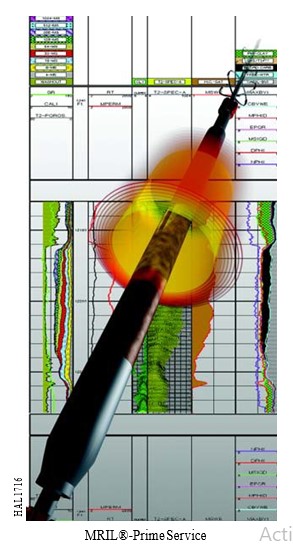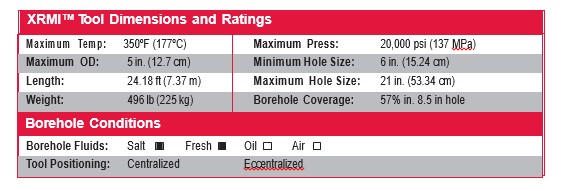Open Hole
MRIL Prime - Magnetic Resonance Imaging Logging
MRIL-XL™ and MRIL®-Prime Magnetic Resonance Image Logging Tools
The MRIL-XL™ tool is the latest family member of Halliburton's wireline NMR logging tools. Both the MRIL- XL and MRIL®-Prime should be considered the first choices for primary formation evaluation in open holes.
NMR logging answers the four basic, critical questions all well operators must answer to understand the economics of a newly drilled prospect:
- Has the well penetrated reservoir rock? (What is the total and effective porosity in a complex lithology environment?)
- What types of fluids (hydrocarbons) are present in the reservoir and how are they distributed?
- What is the ability of the reservoir to produce these hydrocarbons, e. will they flow in this type of formation? (What is the permeability?)
- Will there be associated water production (BVI/FFI)?
The MRIL-XL and MRIL-Prime tools utilize the very same principles as medical MRI by directly measuring the magnetic resonance of hydrogen atoms in fluids. Amplitude of the measured signals gives porosity, whereas the actual signature carries information on rock properties and fluid characteristics.
Applications
The MRIL® tools are used in open-hole logging programs to:
- Obtain minerology-independent measurements of porosity. The MRIL tools truly measure the amount of fluid in the pore space and do not measure rock matr Unlike density, neutron, or sonic porosity devices, which require accurate matrix and fluid-density or Δt-matrix and Δt fluid to compute porosity, the MRIL tools are uniquely a minerology-independent porosity tool(s), yielding clay-bound water porosity, irreducible porosity
(i.e. volume of bound fluid), free-fluid porosity, and total porosity
- Provide a permeability profile along the wel (Note that standard perm values are not calibrated; this requires integration with core data.)
- Provide fluid-typing (gas-oil-water), find fluid contacts, identify changes in oil viscosity
Identify low-resistivity and/or low-contrast pay zone


As an eccentered NMR tool, the MRIL-XL™ signal penetration into the formation is effectively increased in large boreholes, and the effects of drilling mud are eliminated. MRIL-XL service is available with a standard 6-in. sonde to accommodate holes sizes from 7.875-in. to
>12.25-in. and is especially effective in large deviated boreholes. MRIL®-Prime is available in two sizes (slim sonde has 4.875-in. OD and standard sonde has 6-in. OD) to accommodate hole sizes from 5.875-in. to 12.25-in. Both MRIL services may be operated at up to 9 RF-frequencies— allowing data acquisition to be fast and efficient.
- Each frequency creates an independent volume of fluids in the formation, which allows the tool to log considerably faster than any single frequency NMR tool
- Both MRIL services can acquire simultaneous T1 and T2 logs and all MRIL services have maximum temperature ratings of 350°F
- Through-wire and switching sub adapters offer ultimate combinability with other Halliburton tools and competitor tools
- Compatible with drillpipe or tubing conveyed type logging systems in highly deviated wells
- Accurately measures porosity in mixed mineralogy reservoirs
- Improves completion success in low-permeability reservoirs
- Identifies pay zones in laminated, fine-grained sand, and shale formations
- Increases access to reserves by providing complete and accurate analyses of low resistivity/low-contrast intervals
- Identifies zones of water-free production
- Multi-frequency capability allows operators to acquire much more accurate data by combining the measurements made in each volume (at each different frequency)
- Only product to allow combining of different measurements probing different NMR properties of the fluids and formation in one single pass—a major step forward in fluid identification and quantification
- Has successfully pioneered the discovery of oil in zones which triple-combo has traditionally bypassed, leading to increased production of reserves and some spectacular discoveries in even mature production areas
These huge amounts of reservoir information from a single device are extremely valuable for optimizing stimulation and completion programs, thereby optimizing the productivity of each well drilled.
Associated Answer Products
- MRIAN™ MRI analysis – an integrated analysis which incorporates MRIL porosity from T1 and/or T2 plus resistivity data in the dual-water model
- TDA™ time domain analysis – a MRIL only fluids and porosity analysis derived from analysis of the raw NMR echo train data only
- DTW dual wait time analysis – an analysis of hydrocarbon type or types found within each reservoir. Obtained by operating the MRIL service using a short and long Tw (wait time, such as 1s and 12s) in a single logging pass
- DTE dual echo time analysis – an analysis of hydrocarbon or other fluids within each reservoir. Obtained by operating the MRIL service using two different Te (inter-echo spacing, such as a short Te of 2ms and a longer Te of 6ms or longer)


